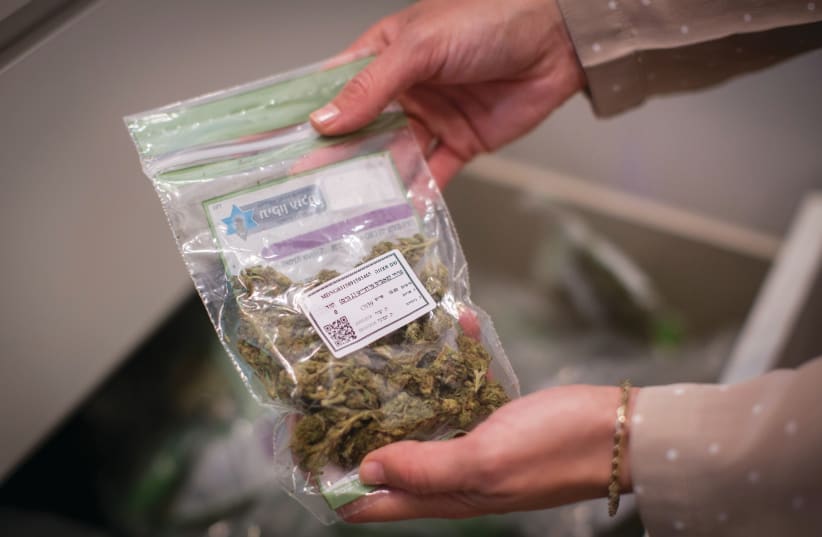“You want to put it on a finger and rub it on your gums,” Ravit continued. “Like you do with coke.”
“Coke?” I replied, confused. “You mean Coca-Cola?”
“No, cocaine,” she replied. “What, you’ve never done cocaine?”
“Um, no,” I sputtered in return.
“But you’ve seen it in the movies, right?” Ravit pressed on.
“I’ve seen actors snort it up their noses,” I said.
“And then they rub what’s left on their gums.”
“Sure,” I said, although the truth is, I never noticed that second step.
Ravit and I were trying to get the dosage right for my second foray into the world of medical cannabis. I had received my first cannabis license from Israel’s Ministry of Health three years ago when I was diagnosed with cancer and wanted a more natural way to counteract the worst side effects of treatment.
At the time, I was mostly interested in CBD, the part of the cannabis plant that doesn’t get you stoned, and which has been all the rage in recent years, showing up in everything from energy drinks to chocolate chip cookies.
CBD didn’t do much for me and my cancer relapsed while I was taking my nightly drops, so I let my medical license lapse.
But when my chronic insomnia took a turn for the worse at the beginning of the COVID-19 pandemic, I began searching for an alternative to the sleeping medication I’ve been hooked on for the last 20 years.
When I first started taking the pills two decades ago, they were a godsend. I’d get seven hours of solid shut-eye and could function again. But the duration of my slumber had been steadily decreasing until, by April of last year, I was on double the recommended dose but getting only a paltry four hours of zzz’s.
That’s a lot of chemicals for not a lot of benefit.
I decided to see a different doctor for my nocturnal malaise. Maybe there were some pills I still hadn’t tried. I didn’t know when I set up our Zoom appointment that my new doc was also a staunch advocate of psychoactive plant use.
Dr. Cannabis told me that I’d essentially exhausted my sleeping pill options.
“What you need is a good Indica with a very high percentage of THC,” he proposed.
There are two main types of cannabis. Sativas rev you up and give you an energetic, happy high. Indicas are sedating and perfect before bed. There’s a handy mnemonic for the latter: Indica – “in-da-couch,” which is where you’ll want to sink after a few puffs.
Dr. Cannabis recommended I start by smoking or vaping, both of which are faster-acting than drops. He punched my information into his computer and sent the request off to the Ministry of Health.
My official diagnosis: PTSD-induced insomnia, which makes sense: My insomnia kicked in big time in 2001 when the Second Intifada was raging and military helicopters were flying over our apartment on their way to Beit Jala. I would lay awake at night getting more and more stressed.
ONCE MY license was approved, the next step was to procure my cannabis.
There are a number of cannabis pharmacies dotted around the country. Some are specialists like Pharm Yarok in Netanya. Others are regular pharmacies, such as your neighborhood SuperPharm. Each stocks dozens of strains from multiple manufacturers. These days, they come in professional packaging – a cardboard box with a Ziploc pouch inside.
Medical cannabis use is still a mostly trial-and-error process. Everybody responds differently to the many varieties available. I started with three 10-gram boxes – one each of “Maple Leaf,” “Og Arsi” and “Neptune.” I’ve never been a pothead, so I didn’t know anything about rolling a joint and keeping it lit. I borrowed a vape pen from a friend and started my journey.
After about a month I had worked up to three puffs before bed while weaning off the pills completely for the first time in decades. To my amazement, I was actually sleeping, albeit not consistently. I wasn’t getting any more rest than I was on the last round of meds.
Discouraged, I called up Dr. Cannabis.
“For PTSD you have to take a lot,” he said. “Three puffs is nowhere near enough. You need three, four times that.”
Twelve tokes is indeed a lot, but after a few nights, it began to have the desired effect. Within about 15 minutes, I was so “in-da-couch” that I would fall asleep nearly immediately. But I would still wake up after a few hours.
It was Ravit who suggested I add a drop or two of Indica oil to the mix, which I picked up on my next pharmacy run.
The oil didn’t prevent me from waking up, but when I did, I would usually fall back asleep. On a bad night, I’d get four hours of sleep. On my best nights, though, I’d be up to six blissful hours – not ideal, but good enough, all things considered.
Is medical cannabis the answer for everyone’s PTSD-related sleep problems? I’m no professional. All I can say is that it’s succeeding for me. For now.
Now, if you’ll excuse me, I have to rub some more Coca-Cola on my gums.
The writer’s book, Totaled: The Billion-Dollar Crash of the Startup that Took on Big Auto, Big Oil and the World, is available on Amazon and other online booksellers. brianblum.com
